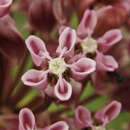pt-BR
nomes no trilho de navegação


Asclepias sullivantii ist eine Pflanzenart der Gattung Seidenpflanzen (Asclepias) aus der Unterfamilie der Seidenpflanzengewächse (Asclepiadoideae).
Asclepias sullivantii ist eine ausdauernde, krautige, aufrecht wachsende Pflanze mit einer tiefreichenden, fleischigen Pfahlwurzel. Die steifen, einjährigen Triebe sind unverzweigt, 60 bis 90 cm (40 bis 110 cm[1]) hoch und kahl. Sie sind leicht mit einer wachsartigen Substanz überzogen. Sie sterben im Herbst komplett ab und treiben im Frühjahr aus dem Wurzelstock wieder aus. Die Blätter sind sehr kurz gestielt bis ungestielt und geständig angeordnet. Die festhäutigen bis leicht sukkulenten Blattspreiten sind breit-eiförmig bis breit-elliptisch oder auch länglich-lanzettlich; 9 bis 15 cm lang und 2 bis 9 cm breit. Das äußere Ende ist breit-stumpf zulaufend bis gerundet, die Basis breit gerundet bis breit und flach herzförmig bis leicht stängelumfassend. Sie sind kahl und leicht wachsartig überzogen. Die Ränder sind leicht gewellt. Die mittlere Blattader ist leicht pinkfarben oder rötlich. Die Blattspreiten sind in Relation zur Sprossachse stark nach oben gerichtet.
Die gestielten Blütenstände sitzen seitlich an den oberen Nodien. Sie sind meist vielblütig (bis etwa 20 Blüten pro Blütenstand) und kugelig. Die kahlen Stiele sind kräftig und 1 bis 6 cm lang. Die Blüten sind eher groß mit 2 bis 4 cm langen Stielen. Die Kelchblätter sind lanzettlich-elliptisch und 5 bis 6 mm lang. Die Blütenkrone ist radförmig mit stark zurückgebogenen, purpurfarbenen bis roséfarbenen Kronblättern. Die Zipfel sind 9 bis 11 mm lang. Die einreihige Nebenkrone ist blassrosa und kurz gestielt. Der Stiel ist breit-verkehrtkonisch, ungefähr 2 mm lang und 2,5 bis 3 mm breit. Die kapuzenförmigen Zipfel der Nebenkrone sind im Umriss breit-eiförmig und 5 bis 6 mm lang. Die hornförmigen Sekundärfortsätze an liegen an den Innenseiten der Zipfel an; sie sind etwas kürzer als Zipfel. Sie sind sichelförmig und am äußeren Ende abrupt nach innen gekrümmt. Der Griffelkopf ist konisch geformt mit einer abgeflachten Oberseite; er ist 3 mm lang und 4 mm breit.
Die Balgfrüchte stehen aufrecht auf U-förmig gekrümmten Stielen. Sie sind dick-spindelig, 8 bis 10 cm lang und kurz geschnäbelt. Die Oberfläche ist gewöhnlich mehr oder weniger stachelig und sehr fein flaumig behaart bis kahl. Die Samen sind breit-elliptisch, etwa 8 mm lang und mit einem weißen, 4,5 cm Haarschopf versehen.
Das Verbreitungsgebiet der Art erstreckt sich über die Prärien von Südkanada (Ontario) über den mittleren Westen der USA (Illinois, Indiana, Iowa, Kansas, Michigan, Minnesota, Missouri, Nebraska, North Dakota, Ohio, Oklahoma, South Dakota, Wisconsin[2]) bis nach Arkansas. Sie wächst dort in etwas feuchteren Prärien, alluvialen Wiesen, und niedrig liegendem Land; verbreitet sich aber auch an den Straßenrändern. Die Blütezeit ist von Juni bis August.
Das Taxon wurde 1848 von Asa Gray nach einem Manuskript oder Manuskriptnamen von George Engelmann erstmals beschrieben[3]. Es sind keine Synonyme bekannt[4].
Asclepias sullivantii ist eine Pflanzenart der Gattung Seidenpflanzen (Asclepias) aus der Unterfamilie der Seidenpflanzengewächse (Asclepiadoideae).
Asclepias sullivantii is a species of flowering plant in the milkweed genus, Asclepias. Common names include prairie milkweed, Sullivant's milkweed, and smooth milkweed.[1][2] It is native to North America, where it occurs in the central United States and Ontario in Canada.[3]
This is a perennial herb growing from deep rhizomes. The stem is 40 centimeters to just over one meter tall. The ovate, pointed leaves are oppositely arranged and hairless. The leaves are also thick and leathery, with wavy margins, reddish midveins. They curve up on the stem. Pale to deep pinkish purple flowers are borne in rounded clusters from the leaf axils. The fruit is a greenish follicle. The flowers are insect-pollinated, but the plant often reproduces vegetatively via the rhizome.[3][4]
This species is very similar to Asclepias syriaca, the common milkweed, and the two easily hybridize. Common milkweed can be distinguished by several characters. Its blunt-tipped leaf blades have a coating of hairs on the undersides and are straight on the stem, not curving up. The flowers are smaller and more numerous, and the surface of the follicle is rougher.[3]
The native habitat of the plant includes prairie and meadows.[2] It grows in moist areas, such as river bottomland.[1] The original range of Asclepias sullivantii was the tall grass prairie, but very little of that habitat remains because of wide spread conversion to farming.[4] In Minnesota it is listed as threatened species, mainly because of habitat loss, and the remaining plants are found on old railroad right ways that preserve small prairie remnants. It is restricted to mesic tall grass prairies and seems to have little ability to survive degraded habitats.[4]
Insects that take nectar from the plant include bumblebees and other bees, wasps, ants, flies, and butterflies. The caterpillars of the monarch butterfly feed on the foliage. The larva of the milkweed leaf-miner (Liriomyza asclepiades) mine the leaves. Aphids that can be found on the plant include the yellow milkweed aphid (Aphis nerii), black aphid (Aphis rumicis), and the green peach aphid (Myzus persicae).[5]
The ruby-throated hummingbird takes nectar.[5]
Most Asclepias are toxic if consumed in large quantities due to cardiac glycoside content.[2]
Asclepias sullivantii is a species of flowering plant in the milkweed genus, Asclepias. Common names include prairie milkweed, Sullivant's milkweed, and smooth milkweed. It is native to North America, where it occurs in the central United States and Ontario in Canada.
Asclepias sullivantii là một loài thực vật có hoa trong họ La bố ma. Loài này được Engelm. ex A.Gray mô tả khoa học đầu tiên năm 1848.[1]
Asclepias sullivantii là một loài thực vật có hoa trong họ La bố ma. Loài này được Engelm. ex A.Gray mô tả khoa học đầu tiên năm 1848.